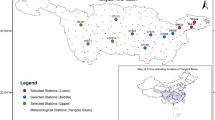Abstract
The Shanghai metropolitan area is physically and socio-economically vulnerable to extreme precipitation events and associated flooding due to its location on the Yangtze estuary, low topography and high density of human activity. This paper presents a statistical analysis for the threshold of daily precipitation extremes at the city scale using percentile indices, probability distribution and detrended fluctuation analysis (DFA). A comparison of the statistical results with consideration of local impact factors suggests that the threshold of daily precipitation extremes over Shanghai increases from 70 mm in the western region to 80 mm in the city centre and then decreases to 75 mm in coastal areas. Finally, further suggestions are presented for decision makers, researchers and other concerned stakeholders to give a more complete picture of urban climatic extremes.


Similar content being viewed by others
References
Bashan A, Bartsch R, Kantelhardt JW, Havlin S (2008) Comparison of detrending methods for fluctuation analysis. Phys A 387:5080–5090
Bell JL, Sloan LC, Snyder MA (2004) Regional changes in extreme climate events: a future climate scenario. J Clim 17:81–87
Changnon SA, Westcott NE (2002) Heavy rainstorms in Chicago: increasing frequency, altered impacts, and future implications. J Am Water Resour Assoc 38:1467–1475
Chen X, Lin G, Fu Z (2007) Long-range correlations in daily relative humidity fluctuations: a new index to characterize the climate regions over China. Geophys Res Lett. doi:10.1029/2006GL027755
He F, Xu J (2006) Studies on precipitation resource change in Shanghai since the 1990’s. J Nat Res 21:210–216 (in Chinese)
IPCC (2007) Climate change 2007: the scientific basis. Cambridge University Press, Cambridge
Kurnaz ML (2004) Application of detrended fluctuation analysis to monthly average of the maximum daily temperatures to resolve different climates. Fractals 12:365–373
Li Z, Zheng F, Liu W, Flanagan DC (2010) Spatial distribution and temporal trends of extreme temperature and precipitation events on the Loess Plateau of China during 1961-2007. Quat Int 226:92–100
Liu B, Chen J, Chen X, Lian Y, Wu L (2013) Uncertainty in determining extreme precipitation thresholds. J Hydrol 503:233–245
Mirza MMQ (2003) Climate change and extreme weather events: can developing countries adapt? Clim Police 3:233–248
Nie C, Li H, Yang L, Ye B, Dai E, Wu S, Liu Y, Liao Y (2012) Spatial and temporal changes in extreme temperature and extreme precipitation in Guangxi. Quat Int 263:162–171
Peng C, Buldyrev SV, Havlin S (1994) Mosaic organization of DNA nucleotides. Phys Rev E 49(2):1685–1689
Shanghai Municipal Statistics Bureau (2013) Shanghai statistical yearbook 2012. (in Chinese)
Shepherd JM, Pierce HF, Negri AJ (2002) Rainfall modification by major urban areas: observations from spaceborne rain radar on the TRMM satellite. J Appl Meteorol 41:689–701
Su B, Gemmer M, Jiang T (2008) Spatial and temporal variation of extreme precipitation over the Yangtze River Basin. Quat Int 186:22–31
Teklu T, Hailegeorgis ST, Thorolfsson KA (2013) Regional frequency analysis of extreme precipitation with consideration of uncertainties to update IDF curves for the city of Trondheim. J Hydrol 498:305–318
Wang C, Zhai P (2009) Changes of precipitation extremes in China’s large cities. Clim Environ Res 14:553–560 (in Chinese)
Wang Y, Zhou L (2005) Observed trends in extreme precipitation events in China during 1961–2001 and the associated changes in large-scale circulation. Geophys Res Lett. doi:10.1029/2005GL022574
Wu X, Yu D, Chen Z, Wilby RL (2012) An evaluation of the impacts of land surface modification, storm sewer development, and rainfall variation on waterlogging risk in Shanghai. Nat Hazards 62:305–323
Xu S (2004) Atlas of Shanghai urban physical geography. Chinese Map Publishing House, Shanghai (in Chinese)
Yang P, Hou W, Feng G (2008) Determining the threshold of extreme events with detrended fluctuation analysis. Acta Phys Sin 57:5333–5342 (in Chinese)
Yang L, Smith JA, Baeck ML, Bou-Zeid E, Jessup SM, Tian F, Hu H (2013) Impact of urbanization on heavy convective precipitation under strong large-scale forcing: a case study over the Milwaukee-Lake Michigan region. J Hydrometeorol. doi:10.1175/JHM-D-13-020.1
Yin J, Yin Z, Zhong H, Xu S, Hu X, Wang J, Wu J (2011a) Monitoring urban expansion and land use/land cover changes of Shanghai metropolitan area during the transitional economy (1979–2009) in China. Environ Monit Assess 177:609–621
Yin Z, Yin J, Xu S, Wen J (2011b) Community-based scenario modelling and disaster risk assessment of urban rainstorm waterlogging. J Geogr Sci 21:274–284
Yin J, Yu D, Yin Z, Wang J, Xu S (2013a) Multiple scenario analyses of Huangpu River flooding using a 1D/2D coupled flood inundation model. Nat Hazards 66:577–589
Yin J, Yu D, Yin Z, Wang J, Xu S (2013b) Modelling the combined impacts of sea-level rise and land subsidence on storm tides induced flooding of the Huangpu River in Shanghai, China. Clim Chang 119(3):919–932
Yin Z, Yin J, Zhang X (2013c) Multi-scenario-based hazard analysis of high temperature extremes experienced in China during 1951–2010. J Geogr Sci 23:436–446
You H, Liu W, Ren G (2014) Variation characteristics of precipitation extremes in Beijing during 1981–2010. Clim Environ Res 19:69–77 (in Chinese)
Zhai P, Pan X (2003) Change in extreme temperature and precipitation over northern China during the second half of the 20th century. Acta Geograph Sin 58:1–10 (in Chinese)
Zhang X, Sun Y, Qi W (2008) Characteristics of long-term daily temperature and precipitation change in Beijing. Sci Meteorol Sin 28:421–425 (in Chinese)
Zhang Q, Zhang J, Yan D, Wang Y (2013) Extreme precipitation events identified using detrended fluctuation analysis (DFA) in Anhui, China. Theor Appl Climatol. doi:10.1007/s00704-013-0986-x
Acknowledgments
This research was supported by the National Natural Science Foundation in China (Grant no: 41201550, 41371493, 41071324, 71373084), the Humanities and Social Science Project of Education Ministry (Grant no: 12YJCZH257), the Innovation Program of Shanghai Municipal Education Commission (Grant no: 13YZ061, 13ZZ035), the Key Project of Young Talent Foundation from Zhejiang Gongshang University (Grant no: QZ13-2).
Author information
Authors and Affiliations
Corresponding author
Rights and permissions
About this article
Cite this article
Yin, J., Zhang, Q. A comparison of statistical methods for benchmarking the threshold of daily precipitation extremes in the Shanghai metropolitan area during 1981–2010. Theor Appl Climatol 120, 601–607 (2015). https://doi.org/10.1007/s00704-014-1199-7
Received:
Accepted:
Published:
Issue Date:
DOI: https://doi.org/10.1007/s00704-014-1199-7




